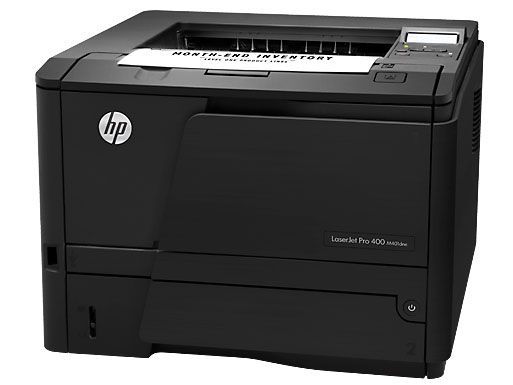Four Entry-Level Monochrome Laser Printers, Reviewed
HP LaserJet Pro M401dne
The HP LaserJet Pro M401dne tries to be a higher-end printer than it really is, leading to some successes and some failures, depending on the test.
Right away, the M401dne is the most difficult printer to set up. While every competing model requires only that you attach a USB cable, the HP wants you to start by spinning up an installation CD. This initiates a rather lengthy process where the computer and printer talk to each other for a few minutes, and it includes the installation of HP's update app that requires accepting a license agreement. It also asks for permission to send printing data back to HP, which can thankfully be denied; we see no reason anyone would want to share that information.
The payoff for going through those extra steps is a more robust interface for monitoring the M401dne's status. In fact, the LaserJet Pro is the only printer that automatically displays a status window on the host machine any time a document is printed. This pop-up lets you know how much of a print job is complete, toner level, and any error messages that need to be conveyed along the way (like an empty paper tray).
In terms of speed, the M401dne holds its own in our text printing test, finishing the 30-page workload in exactly one minute. That text looks fantastic on paper, too. Letters are crisp and well-formed. Even scrutinized through a photo loupe, the printer's output is pretty much perfect. All of the printers in today's story do well with text. Even so, HP's is noticeably better.
The wheels come off when we try printing the 30-page graphical document, though. We've seen this before, but it's been a few years. The workload we're using is huge, including almost 60 MB of content. If a printer doesn't have enough memory, errors can happen. And that's exactly what we saw from the M401dne, which simply refused to finish printing the document.
I did manage to get all 30 pages from the M401dne after a reboot. It had to stop several times along the way though, with delays that lasted over a minute as the printer crunched our test document one page at a time. By the time the last page was done, 5:50 had passed.
The output was quite good, second only to Dell in quality (and not by much). HP does particularly well with darker images and placing letters over graphics.
Get Tom's Hardware's best news and in-depth reviews, straight to your inbox.
The M401dne also offers robust security, including the ability to set up a password-protected embedded Web server, SSL certification management, a firewall, and an access control list to prevent unauthorized users from sending documents to the printer or accessing other peoples' print jobs.
If all you ever need to do is print text securely, then HP's LaserJet Pro M401dne is a great choice. But if graphics play into your decision, the M401dne isn't your best choice.
Current page: HP LaserJet Pro M401dne
Prev Page Brother HL-6180DW Next Page Xerox WorkCentre 3320/DNI-
blackmagnum Perfect timing for the office upgrade. These laser printers definitely offer better printout/ price ratio compared to ink jets.Reply -
phate1337 Hey, I recommend you try and get your hands on a low end Kyocera desktop printer. as an engineer that has worked on many many brands of printers, scanners and photocopiers, the most reliable by far has to be Kyocera for desktop A4 Mono printers.Reply -
cypeq For regular desktop printing (that's their goal) any would do, they all well... print, your only guideline should be prints per month, if you want proper durability of device.Reply -
Achoo22 The Dell sometimes goes on sale - I've seen it drop well below $100 in the past, including free shipping. I've used lots of devices from Brother in the past, and their drivers tend to be among the worst in the business in terms of stability and OS support. When Windows 9/Ubuntu Next/Plan9/whatever comes out, don't be shocked if you're without print services for a while. Being able to hold a whole ream of paper at once is pretty awesome, though, and means an awful lot more in practice than shaving a few seconds off of a print job.Reply -
Someone Somewhere Would be nice if you'd posted the toner cartridge sizes and costs, too. Many budget lasers come with cartridges only in the ~700 page range, which is better than an inkjet but still relatively small.Reply -
XGrabMyY My favorite entry level laser printer is by far the 2270DW by Brother. I can buy 6000 page yield cartridges for about 12.50USD, and they last for that long. It is unreal how much value you get for a 90-120USD printer (I spent about 90 to a 100 for each of my two) and they duplex and have wireless printing - super easy to setup AND Brother even supports Windows 8/8.1 RT. You really can't ask for anything better!Reply -
amk-aka-Phantom As a sysadmin with dozens of Ubuntu systems under control, the choice is easy. HP, because it's the only thing that's decently supported :D (And use 3rd party cartridges to avoid being ripped off by HP)Reply -
Someone Somewhere Printing works fine on both my Brother and HP network printers, on Ubuntu and Windows. Never had driver issues with either.Reply -
bloody llama The article doesn't mention anything about longevity or ease of repair on these printers. I understand that it is somewhat outside the scope of a simple review, but my experience with laser printers has lead me to believe that the brother printers last much longer and are much easier to repair over the long haul. Try letting an office of real estate agents abuse one for a decade and that gets real important.Reply -
vaughn2k In the Philippines, we have this Brother Printer HL-1110 (http://welcome.brother.com/ph-en/products-services/printers/hl-1110.tab1.html), costs U$67.0 and can print 21ppm. ;)Reply


